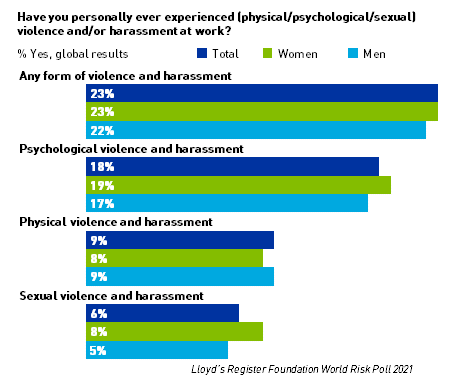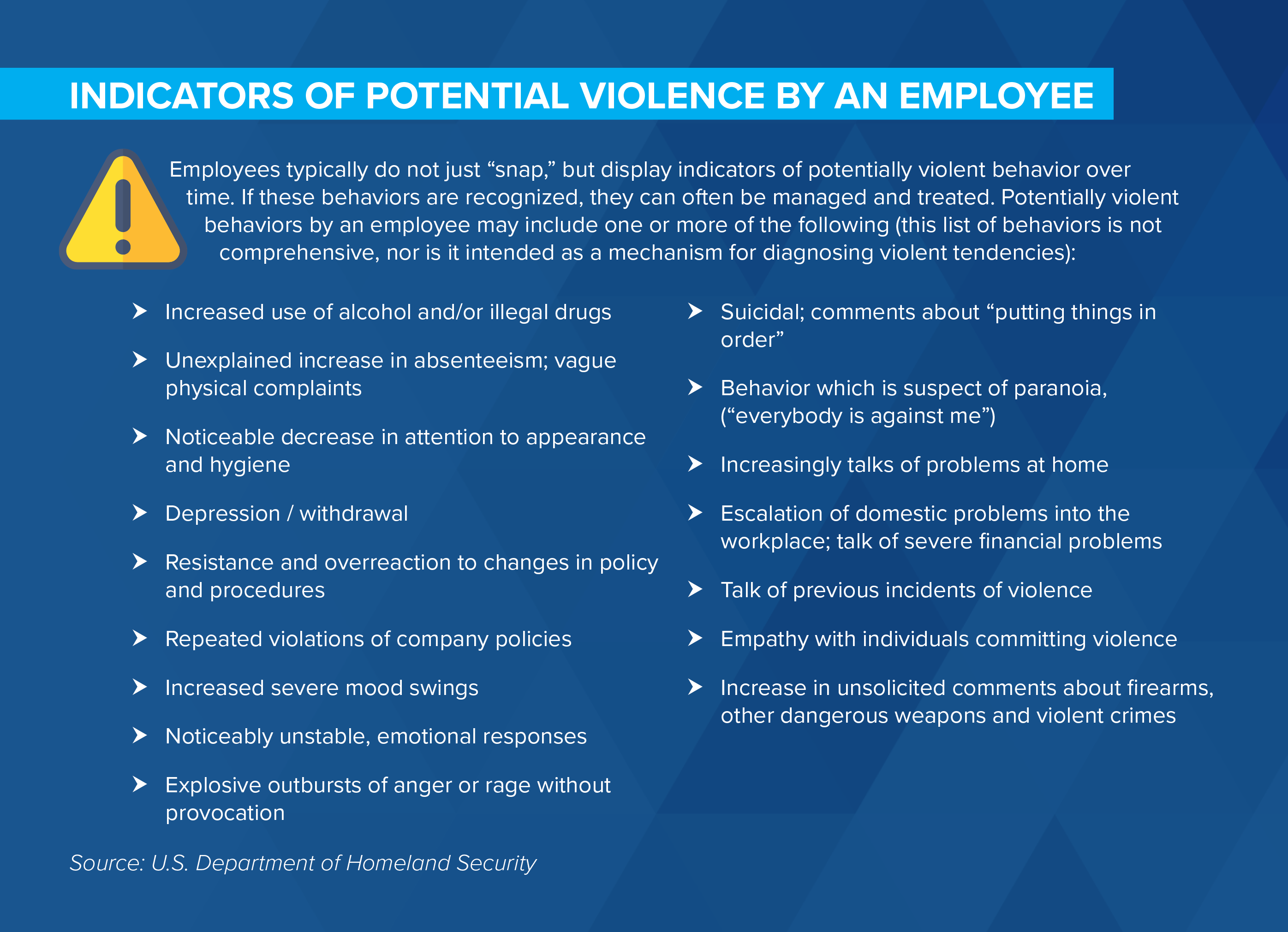Workplace violence is any act or threat of physical violence, harassment, intimidation, or other threatening disruptive behavior that occurs at the work site. It ranges from threats and verbal abuse to physical assaults and even homicide. It can affect and involve employees, clients, customers, and visitors. Acts of violence and other injuries is currently the third leading cause of fatal occupational injuries in the United States.
Most people think of violence as a physical assault, but it can be a much broader problem. It includes any form of threatening or disruptive behavior and can be as simple as a gesture or as complicated as sabotage. Acts of workplace violence include:
- Threatening behavior such as shaking fists, vandalism or throwing objects.
- Verbal or written threats including any expression of an intent to harm.
- Harassment or any behavior that demeans, embarrasses, humiliates, annoys, or alarms another person.
- Any behavior that is known to or would be expected to be unwelcome including words, gestures, intimidation, bullying, or other inappropriate action.
- Verbal abuse including cursing, insults, or condescending language.
- Physical attack including hitting, shoving, pushing, kicking, etc.
At Mauser Packaging Solutions, our policy against workplace violence is rooted in the belief that all workers have the right to a safe workplace, and we must always respect fellow employees. Violent behavior will never be tolerated, and everyone has a responsibility to refrain from and report behaviors that are threatening or that may indicate the potential for violence. Mauser expressly prohibits all conduct that can be directly or indirectly construed as workplace violence in/on Company property and all premises where work-related activities are performed. Employees are prohibited from making threats or engaging in acts of intimidation, harassment, or other threats of or actual violence. Threats of or actual acts of intimidation, harassment, or violence are also prohibited through any Company or personal electronic communications system, including by cell phone or email. Any employee who witnesses or learns of any indirect or direct threats of violence, incidents of actual violence, and suspicious individuals or activities must report it as soon as possible to a supervisor, management team, security personnel, and/or local HR representative. When reporting a threat or incident of violence, the employee should be as specific and detailed as possible. Employees should not place themselves in peril while attempting to report the incident.
- Change in behavior
Changes in an individual’s behavior (such as sudden mood swings or depression, decrease in personal hygiene, increase in lateness or absenteeism, or deterioration in job performance) can indicate underlying issues that could cause a person to behave in a violent manner. - Change in circumstances
Changes in circumstances can create stress and lead some people to react in violent ways. Examples include workplace policy changes, schedule changes, personnel changes, personal life changes, or financial problems. While changes may be unavoidable, being aware of the emotional impact changes have on us and others can enable us to cope with change in a positive manner. - Increase in negative behavior or attitude
An increase in negative behavior or attitude is often a pre-cursor to violent behavior. Acknowledging and addressing and increase in negative behavior can help prevent escalation to violence. - Signs of alcohol abuse, drug abuse or mental health issues
Any circumstance that alters cognitive ability can be a warning sign for violence. When a person is not in full control of their mental capacity, whether from a substance such as drugs or alcohol or from a mental health issue, there is the potential for behavior (including violence) that would be outside the person’s normal manner. - Horseplay
While horseplay often begins harmlessly, it often escalates and can turn into violence. Horseplay includes physical actions (such as pushing, running, or chasing), verbal behavior (such as insults, bullying, offensive jokes), practical jokes and goofing off. In addition to the potential for escalation, horseplay also poses inherent safety risks and should never take place in the workplace.
For threats that emanate from inside the workplace, the way we engage with people can diffuse situations before violence occurs. There are precautions everyone should take to minimize or prevent violence on the job. For example:
- Don’t get drawn into an argument. Loud and aggressive confrontations can easily escalate into physical violence.
- Take verbal threats seriously, but don’t respond to them.
- Report all threats to your supervisor immediately.
- Report all incidents of bullying or harassment.
- Always follow directions of your supervisor during an emergency.
When dealing with an agitated and potentially dangerous person or situation, personal safety is the most important priority. Following some basic recommendations can help keep you safe and potentially prevent further escalation:
- Remain calm and speak slowly, softly, and clearly. Stay in control of your own emotions and don’t match the tone or volume of the person with whom you are interacting.
- Allow the person some space (2-4 feet); do not glare or stare.
- Do not tell the person to calm down.
- Pay attention and do not argue, criticize, or interrupt.
- If you feel it necessary, quietly leave the situation and get help; never turn your back on a person that you believe to be a threat.
In addition to preventing internal threats, we all have a responsibility to help prevent external threats from entering the workplace. The easiest way to prevent external threats is to be diligent about who we allow access to our facilities and offices. By following these guidelines, we can minimize the potential for external threats to enter our workplace:
- Watch for unauthorized visitors, even those who appear to have legitimate business at your plant; crimes have been committed by people posing as employees, contractors, and repair technicians.
- Report any suspicious person, vehicle, or activity to your supervisor.
- Make sure all visitors sign in, that they are properly identified and escorted through the plant.
- Never let anyone borrow your keys, key cards or means of access/identification.
- Never give out information about fellow employees.
- Make sure that doors that are supposed to be locked remain locked; don’t prop open doors.
As with all other aspects of safety, every employee shares the responsibility of making sure everyone goes home safe every day. Regarding workplace violence, this mean that we all share responsibility for our individual behavior to restrain from violence and avoid actions that may incite others to violence. When we all accept responsibility for creating the environment or circumstances that facilitate safety, we can put into force meaningful change that ensures a safe workplace for everyone.



